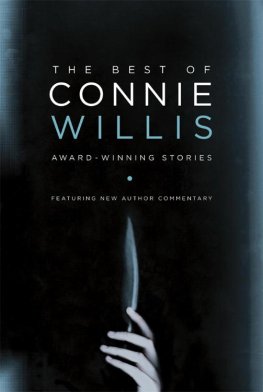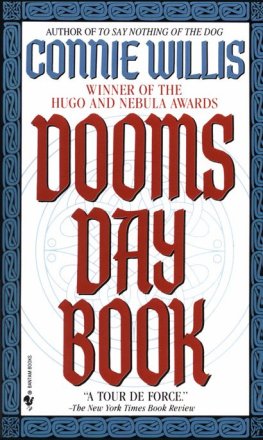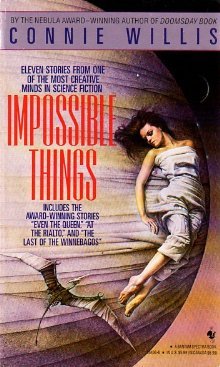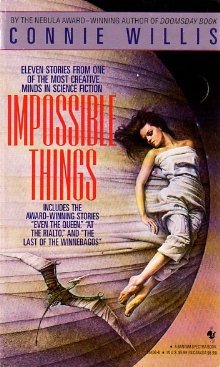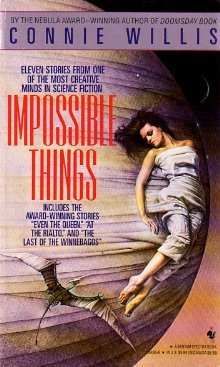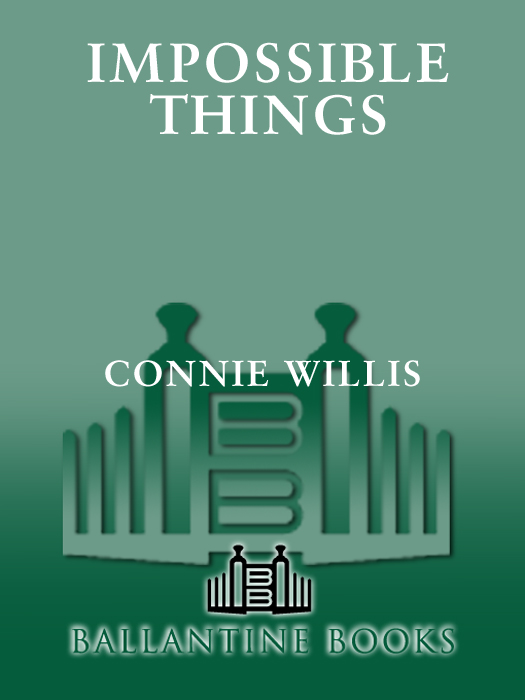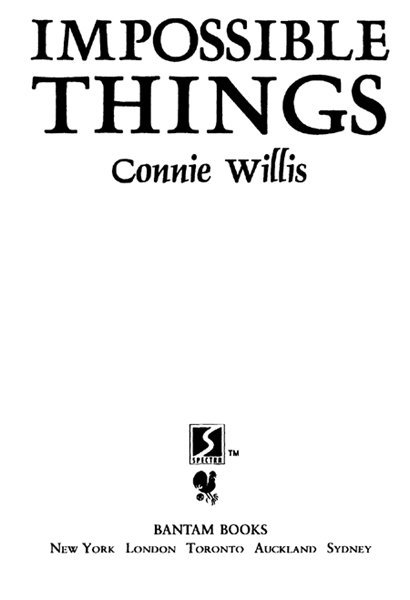IMPOSSIBLE THINGS
In Even the Queen, liberated women try to come to terms with the womens issue.
Political correctness and religious vigilance run amok on campus in Ado.
In Time-Out, an incredible experiment turns a small town upside down.
An illiterate woman uncovers the ultimate Shakespeare conspiracy in Winters Tale.
In In the Late Cretaceous, it becomes clear what killed the academic dinosaurs of a university paleontology department: relevance.
Hollywood becomes the proving ground for the theories of quantum physics in At the Rialto.
BANTAM BOOKS BY CONNIE WILLIS
Doomsday Book
Lincolns Dreams
Impossible Things
Remake
Uncharted Territory
Bellwether
Fire Watch
To Say Nothing of the Dog
Passage
Miracle and Other Christmas Stories
IMPOSSIBLE THINGS
A Bantam Spectra Book / January 1994
PUBLISHING HISTORY
The Last of the Winnebagos first appeared in Asimovs Science Fiction 1988.
Even the Queen first appeared in Asimovs Science Fiction 1992.
Schwarzschild Radius first appeared in The Universe, ed. by Byron Preiss, Bantam Books, 1987.
Ado first appeared in Asimovs Science Fiction 1988.
Spice Pogrom first appeared in Asimovs Science Fiction 1986.
Winters Tale first appeared in Asimovs Science Fiction 1988.
Chance first appeared in Asimovs Science Fiction 1986.
In the Late Cretaceous first appeared in Asimovs Science Fiction 1991.
Time Out first appeared in Asimovs Science Fiction 1989.
Jack first appeared in Asimovs Science Fiction 1991.
At the Rialto first appeared in Omni 1989.
SPECTRA and the portrayal of a boxed s are trademarks of Bantam Books, a division of Bantam Doubleday Dell Publishing Group, Inc.
All rights reserved.
Copyright 1993 by Connie Willis.
No part of this book may be reproduced or transmitted in any form or by any means, electronic or mechanical, including photocopying, recording, or by any information storage and retrieval system, without permission in writing from the publisher. For information address: Bantam Books.
eISBN: 978-0-307-78445-2
Bantam Books are published by Bantam Books, a division of Bantam Doubleday Dell Publishing Group, Inc. Its trademark, consisting of the words Bantam Books and the portrayal of a rooster, is Registered in U.S. Patent and Trademark Office and in other countries. Marca Registrada. Bantam Books, 1540 Broadway. New York, New York 10036.
v3.1
Dedicated with love and gratitude
to Mrs. Jones
and Lenora Mattingly Weber
CONTENTS
FOREWORD
by Gardner Dozois
Editor, Asimovs Science Fiction Magazine
Connie Williss first published story, The Secret of Santa Titicaca, was ferreted out of a magazine slush pile by an eager, bright-eyed young slush reader named Gardner Dozois, and was published in the winter 1970 issue of Worlds of Fantasy magazine. Although the story embarrasses Connie tremendously (I doubt youll ever see it in one of her collections), and indeed shows only a few flashes of her later wit and style, it is a decent enough light fantasy, unexceptional but solid novice work, nothing to be ashamed of, and certainly much better than, say, my first published story. As it turns out, though, I did Connie no favor by fishing her story out of the slush pile, since its appearance in 1970 disqualified her for consideration for the John W. Campbell Award for Best New Writer later in the decade when she began making a stir with more mature work, and in fact may well have cost her the award, for which she was a heavy favorite. So it goes. We never know all the consequences of our actions, and the intentions behind them sometimes matter littlea very Connie Willis-like moral.
Ever since then, however, Ive felt a proprietary interest in Connies career and have kept a careful eye on it.
Its been quite a career to watch, too.
The Secret of Santa Titicaca sank out of public consciousness without arousing a single ripple (something for which Connie was probably grateful later on), and Connie was subsequently not heard of again until the late seventies, when she started attracting attention with a number of striking and unusual stories in the now defunct magazine Galileoone of those stories, Daisy, in the Sun, marked her first appearance on major award ballots, and was her first story to be selected for a Best of the Year anthology; it was far from her last such story to have such honors bestowed upon it, however.
Connie first attracted really serious attention with her first major story, Fire Watch, which won both the Hugo Award and the Nebula Award in 1982. Her story A Letter from the Clearys also won a Nebula Award in 1982, and suddenly a lot of other people were watching Connies career as well. They were going to have a lot to look at.
In the eighties Connie became one of the mainstays of Isaac Asimovs Science Fiction Magazine and also appeared regularly in markets such as Omni, The Magazine of Fantasy and Science Fiction, The Twilight Zone Magazine, Whispers, and elsewhere. She was becoming one of the most prolific and popular short-story writers of the day. Her first collection, Fire Watch, appeared in 1985. She published two entertaining but relatively minor collaborative novels with Cynthia Felice, Water Witch and Light Raid, and then, in 1987, published an outstanding first solo novel, the quietly moving Lincolns Dreams, which I regard as one of the best novels of the decade. She again won both the Hugo and the Nebula awards in 1989 for her novella The Last of the Winnebagos, and won another Nebula Award in 1990 for her story At the Rialto. Then, in 1992, she published a major new solo novel, Doomsday Book, one of the most successful and critically acclaimed novels of the year, and a good indication that Connie will probably be as prominent in the decade of the nineties as she was in the decade just past.
Which brings us to the book you hold in your hands at this moment, Connie Williss second collection of short fictionConnie Williss long-overdue second collection of short fiction, one might even fairly say, considering that she may well have been the most consistently honored short-story writer of the eighties, and certainly one of the most influential.
It might have been less long in coming if Connie had bothered to learn the art of perpetual hype and constant self-promotion mastered by several of her peersbut thats not Connies style. Not that she couldnt master it if she wanted to; very little is beyond her.
Because she wears Peter Pan collars, and looks relentlessly cheerful and normal, and talks openly about going to Tupperware parties and choir practice, and has a deadpan and ferociously sardonic sense of humor, and is after all a suburban housewife and mother, people tend to underestimate Connie. This is a serious mistake. Connie is as tough-minded and smart as anyone in the business. One is tempted to trot out an old clich and say that Connie has a mind like a steel trapexcept that in Connies case it would be some much rarer and more subtle device, something with mirrors and lasers perhaps, that would somehow give the mice such a good laugh that theyd never even notice that their throats were being cut.


